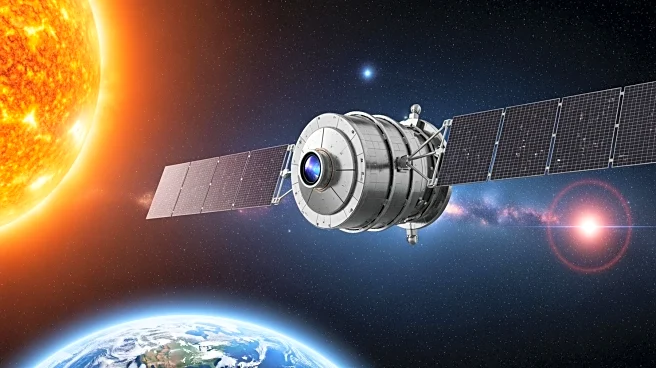What's Happening?
The U.S. National Oceanic and Atmospheric Administration's (NOAA) weather satellite, GOES-19, recently captured a unique image where Earth appeared to photobomb the sun. This image was taken by the satellite's CCOR-1 coronagraph, which is designed to capture real-time
images of the sun's outer atmosphere, known as the corona. The image, shared by NOAA's Space Weather Prediction Center, shows Earth silhouetted against the solar corona. GOES-19, launched in 2024 and operational since early 2025, monitors Earth's weather and the surrounding space environment from a geostationary orbit approximately 22,000 miles above the equator. The satellite's instruments, including the CCOR-1, are sensitive enough to capture faint solar structures even when bright objects like Earth enter their view.
Why It's Important?
This event underscores the capabilities of modern space weather monitoring technology. The ability of GOES-19 to capture such detailed images of the sun's corona is crucial for understanding and predicting space weather phenomena, such as coronal mass ejections (CMEs). These CMEs can have significant impacts on Earth, affecting satellites, power grids, and communication networks. The image also serves as a calibration test for the CCOR-1 instrument, helping scientists assess how it handles stray light and reflections. This contributes to more accurate monitoring and forecasting of space weather, which is vital for protecting technological infrastructure and ensuring the reliability of communication systems.
What's Next?
The continued operation of GOES-19 will provide ongoing data to improve space weather predictions. Scientists will use this data to refine models that forecast the impact of solar activity on Earth. As space weather monitoring technology advances, it is expected to enhance the ability to mitigate the effects of solar disturbances on critical infrastructure. NOAA's efforts in this area are likely to lead to more robust systems for managing the risks associated with space weather events.
Beyond the Headlines
The image captured by GOES-19 highlights the intersection of technology and natural phenomena, showcasing the importance of advanced instruments in understanding the universe. It also reflects the growing need for international collaboration in space weather research, as the effects of solar activity are global. The development and deployment of such satellites are part of broader efforts to safeguard human activities from the unpredictable nature of space.
















